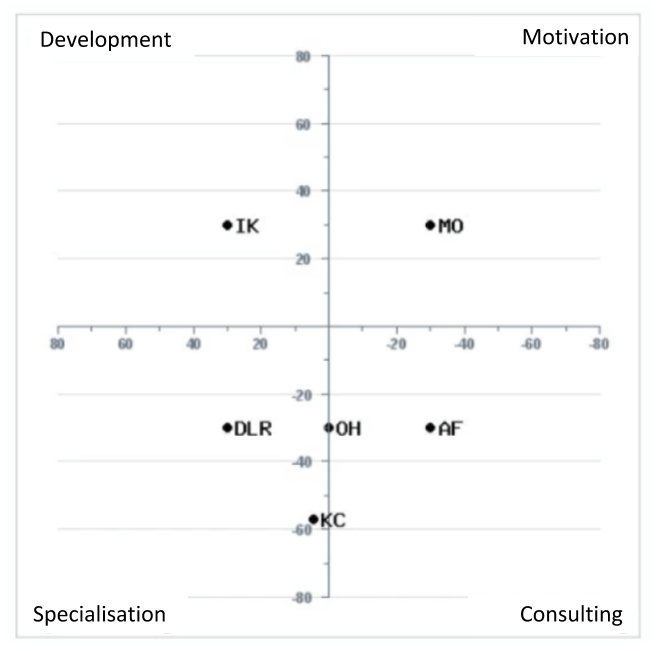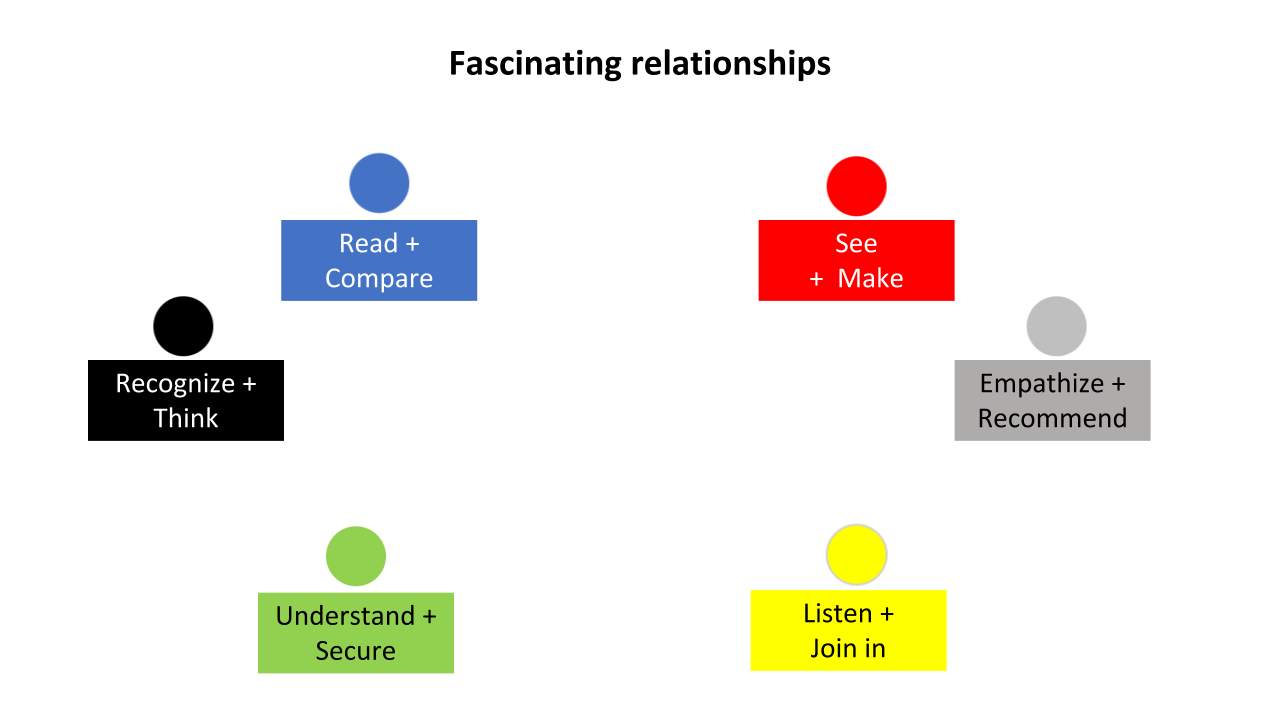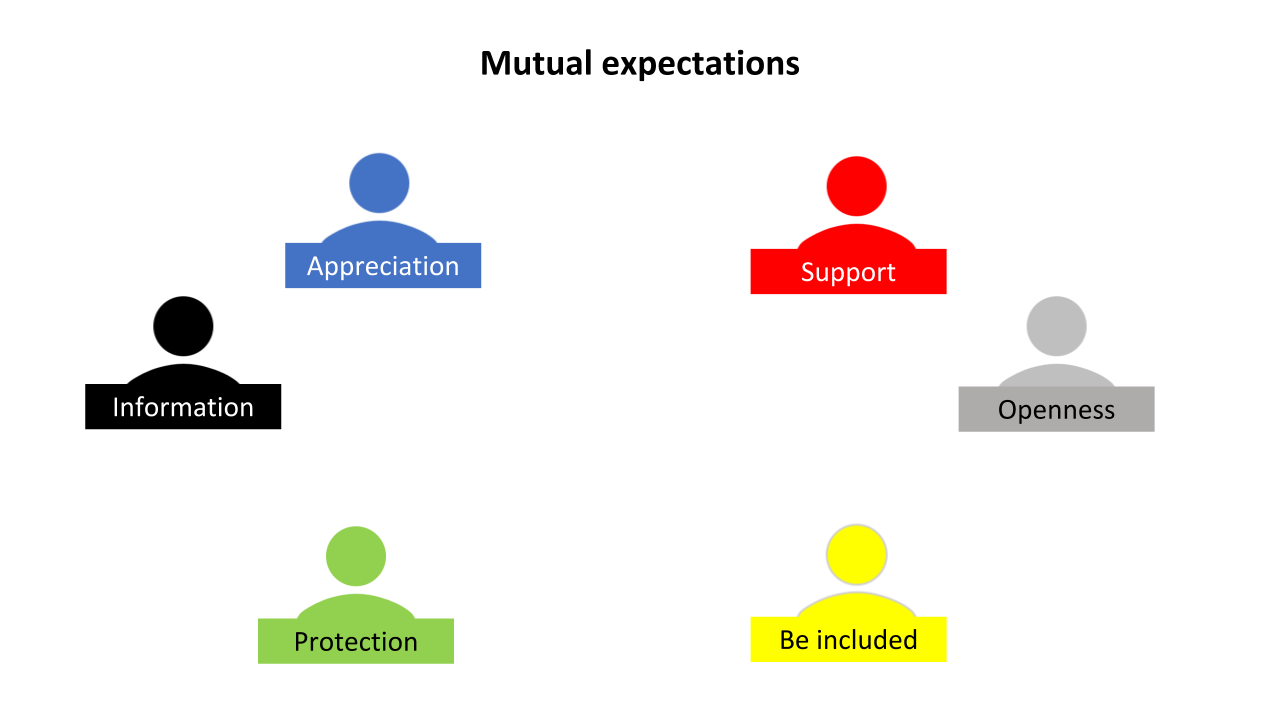Team management
The future is determined by the team. After routine work and controllable processes have been transferred to technology, the focus in modern organizations is on exceptions, on everything that cannot be controlled - forced adaptation and improvement processes.
The rapidly growing complexity resulting from these processes requires a
new way of working in teams. 
It is not enough for members to be willing to follow instructions - computers are better able to do that. When the question "What should I do?" is replaced by "What can I do for myself and for my team?", a dynamic is created that leads with verve into a lively and successful future.
Recognize potential synergy effects
In order for energy to become active, we need a "gradient" - for example between the height of a need and the situational offers. If you want to see something, you need light. The darker it is, the stronger the energy to get involved in a lamp.
In a team, typical conflicts arise from different needs. While one colleague is committed to "enlightenment", the other is looking forward to the increasing darkness, because then one can feel, feel and dream better.
The "inner" system of a human being is determined by the simultaneity and contrariness of the existential basic needs. In order to survive as individuals or as species, we humans strive for assertiveness, belonging, security, individuality, empathy and insight. These basic needs have the greatest impact. Because of their existential character, they create fears when their fulfillment is threatened, and powerful actions when satisfaction seems possible.
One or more of these aspects will be prioritized according to personality. One develops into an extroverted entertainer, a dynamic entrepreneur, a critical researcher and so on.
This makes every team a meeting of people with different priorities. They bring in their individual characteristics, which have developed as a result of long-established behaviours. Behaviour serves certain needs. In order to survive as individuals or as species, we humans strive for assertiveness, belonging, security, individuality, empathy and insight. These basic needs are the source of the forces that make life possible. Due to their existential character, however, they also give rise to fears when their fulfilment is threatened, and powerful actions when satisfaction seems possible.
The task of team management is to recognize and channel these energies that are striving in different directions.
The purpose of the IPM system is to make the complex interrelationships transparent and to align the associated forces with the company's common goals by means of leadership instructions and team profiles.
The competences resulting from the interaction of two forms of energy are deliberately used for this purpose. Here is a presentation from the team profile.

The team shown in this example is represented in each of these fields of competence. There is, however, a greater tendency towards specialisation and consultation, so that in practice "IK" and "MO" can find it difficult to convince colleagues of their ideas and plans. The two top candidates are well advised to sell to the 6 more down-to-earth team members, which is why their projects make a lasting contribution to stability.
Enforcement: develop the dynamics
If you look at the control loop of successful change processes, you can see how very different competences are used in a certain order. Dynamism arises when the forces are bundled and activated according to the situation. Team management is easy when you know who can make what contribution.
An employee with a high need for security and continuity will react differently to change projects than, for example, a colleague who loves things to happen. Such basic conflicts cost a lot of energy, time and money if they remain undiscovered, because people tend to always act in the sense of their own feelings when in doubt.
 Ideally goals and change projects are communicated in such a way that these
emotional resistances are excluded. Target synchronization is necessary if,
for example, the marketing manager presses for participation in a trade fair,
while the head of finance wants to reduce all his budget. If you don't
advertise, one of them will die. Many companies have already broken their
hopes, the other one.
Ideally goals and change projects are communicated in such a way that these
emotional resistances are excluded. Target synchronization is necessary if,
for example, the marketing manager presses for participation in a trade fair,
while the head of finance wants to reduce all his budget. If you don't
advertise, one of them will die. Many companies have already broken their
hopes, the other one.
Of course both are right - and certainly there are more complex situations in which decisions have to be made and enforced. In principle, however, it amounts either to lukewarm compromises (taking a bit of action and doing a little harm to the company) or to unilateral decisions that deprive the other side of any desire for further commitment (one of the reasons for the internal dismissals).
IPM shows in the team profiles which decision priorities are set by which employee. The emotional distances between the participants are visualized and it already becomes clear that the colleagues are no crackpots or slowers, but can make strategically and economically meaningful contributions in the sense of the company. One has ideas and the other analyses the feasibility and consequences and so on.
Everyone makes his or her personal contribution in the decision-making cycle and is accepted with his or her special characteristics. This improves the mood, the willingness to get involved and enables personality-related synergies. Belonging and empathy, for example, complement each other very well when it comes to swearing the team to common goals and developing joint action concepts during implementation and recognition. Synergy can be experienced.
Relations with "strangers" are fascinating
Deep motivation describes which of the existential basic needs have the highest priority for the individual. Since these structures almost always have an effect from childhood on, different characteristics are formed.
The fascinating thing about a heterogeneous team is that the differences become so clear that it no longer takes any effort to perceive colleagues and appreciate their current priorities.
To allow the chances from the differences sounds easier than it is in practice, because the participants must know that they can and should think, feel and act independently!
The leadership of the team, moderated by IPM and supported by the team profiles accessible to all, provides the answer to the questions that arise when all participants begin to take responsibility for a joint project: Each in his or her own way and to the best of his or her ability.

IPM answers the question: "Who do I motivate and lead in which way? with the individual leadership instructions.
Each employee is described in terms of his or her personality, how he or she achieves positive motivation and what needs to be taken into account in general communication and agreements on work content.
But team members also receive such portraits of their superiors and colleagues. On the one hand, the particular strengths of each partner are considered, and on the other hand the relationship level is reflected:
Where am I different from my colleagues? What is my position in the team like? What should I do to feel comfortable working with my team?
The long-term goal is to have well-integrated employees who are enthusiastic about their tasks. Especially when forming new teams or changing the composition, there is a great opportunity to question the usual "you have to take yourself back and adapt to the majority" - because it hampers team dynamics and can eventually lead to a paralyzing juxtaposition.
The more creative and productive a team is, the less pressure there is to adapt, the greater is the willingness to perceive with a smile and fascination that all of their endearing peculiarities contribute.
To be able to rely on each other
Everyone should take on the tasks they feel comfortable with in the team according to their personal inclinations. To act naturally in the way one has been accustomed to since childhood makes you self-confident.
But also in the perception of the other team members, a secure self-image is created. If someone who likes to analyse things makes a fool of the numbers, that's quite simply okay. Everyone knows that you can rely on your colleagues.
Using employees in such a way that they are permanently entrusted with tasks they can and want to perform in a pleasant environment is a perfectly reasonable goal.

It is not only human but also economically sensible for everyone to "be allowed" to achieve his optimum and not to struggle with something that does not suit him.
The team composition with its distribution of tasks requires order. Starting from a common goal, detailed goals are derived which are to be achieved by completing certain tasks.
Whoever does what corresponds to him - in a way that suits him - does not need control, but rather a reflection or coordination that suits him. It is clear to everyone: one can rely on each other. And this basic feeling ensures that you also reliably contribute to the team dynamics.
In a well-structured environment, many imponderables can be avoided. On free paths you can move better towards your goal.
Reliability and continuity are the result when you know about each other and appreciate each other. It is clear, predictable and naturally safe how someone behaves and communicates when the tasks are fairly distributed = doing justice to the employee, respecting him.
Self in demand and feeling valued
Those who work on tasks that suit them and in a team of people who value them the way they are will be better motivated, more efficient and healthier on their own initiative than those colleagues who have already resigned internally.
Team management hardly needs to do anything to create this positive atmosphere: you just have to be honest and interested in your colleagues.
The motivation profiles of the individual group members show their preferences, strengths and expected competencies. They also provide information on relationship management, emotional language and much more. You can print out this information about yourself, give your colleagues operating instructions - or give them access to their own portraits via the Internet: "Here are a few hints on the things I like to do or where I can support you.
Talking about yourself in this way is good because there is nothing negative in the whole construct of motivation profiles - simply because existential needs can't be bad. We need air to breathe, space to unfold, belonging and more. Who wouldn't accept that?
The team profile shows for different dimensions in which direction the individual team members feel "drawn". Here is an example of the dimension blue (individuality) versus yellow (integration):
Should one adapt oneself and act according to the expectations of the environment or draw attention to oneself through uniqueness? Everyone has to deal with the opposing striving for individuality (recognition) and integration (adaptation).

Depending on the personality you will find your own balance between both poles. Both sides are important for good teamwork. Ideally, everyone can be proud of their achievements and feel equally well integrated.
Values in the "blue" range above 20
These team members feel comfortable when they are asked and when they are asked. Because they don't like a superficial conversation, they tend to hold back on communication. You should always ask them in a team to be critical about work or plans. Their individual views are valuable to all involved. They ensure quality.
Values in the range between -20 and 20
These personalities with almost equally strong aspirations for individuality and belonging know many situations in which opposing tendencies had to be coordinated. They bring the resulting skills, such as coordination skills, to the team. If you let them, they ensure mutual understanding and the bundling of forces towards a common goal.
Werte im "gelben" Bereich größer 20
Such people are often experienced as extroverted. They seek contact and adapt to their interlocutor - this promotes communication and benefits both teamwork and the involvement of third parties. They ensure communication.
Empathy: well balanced balance for all in the team
The more colourful a team is, the more comprehensive is the quality of the expected results. The more exposed an individual's position in the team is, the greater its significance for the others.

Balance occurs when tensile force or pressure are balanced on both sides. IPM expresses this with the complementary colours. Red needs green. Black needs white. Yellow needs blue.
Round decisions need a round team. Any one-sidedness leads to inner or outer resistance, because then you don't perceive the other side sufficiently.
This perception and being perceived is an essential concern of empathy. Those who use their empathy feel with themselves and their colleagues in the team whether and to what extent mutual expectations are fulfilled.
Use the team profile for a detailed analysis and the matrix function to visualize possible alternatives.